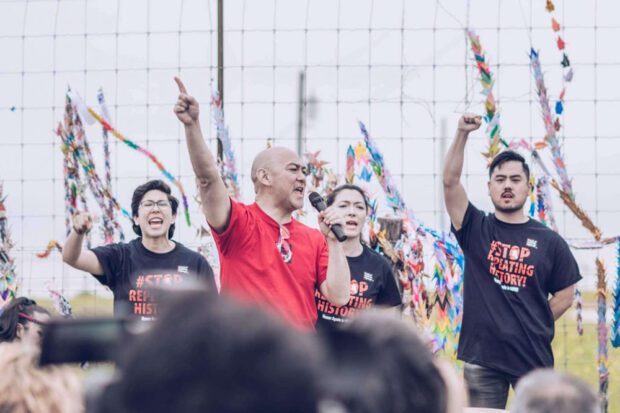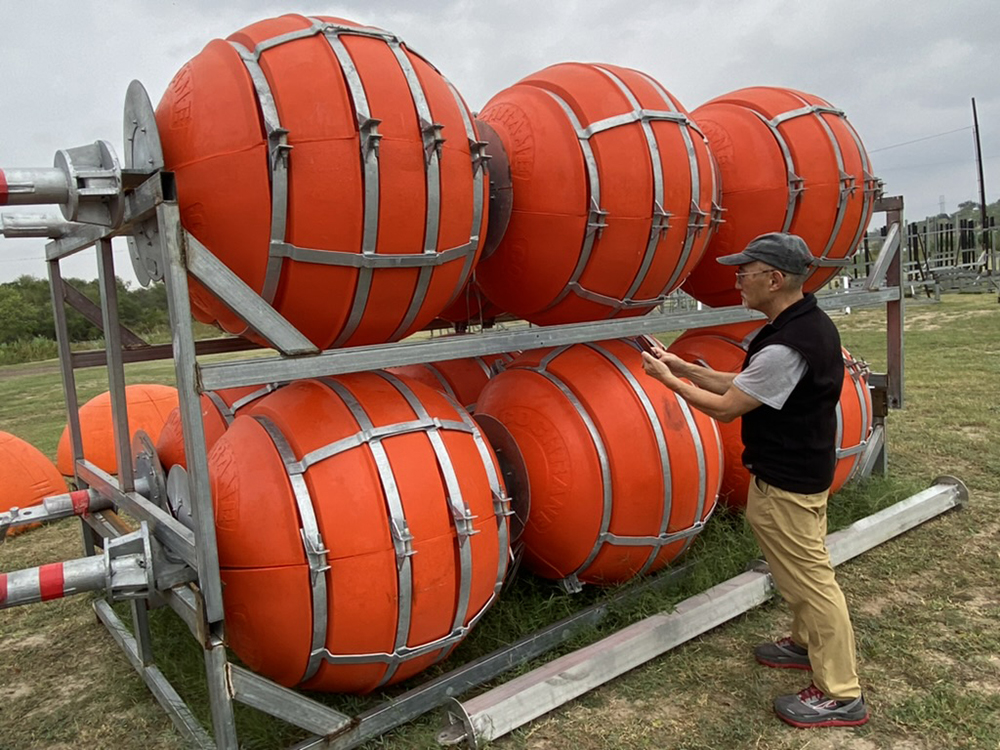

Japanese cranes, known as Tsuru in the Land of
the Rising Sun, are elegant and statuesque birds with national treasure status. In Japanese culture, the crane symbolizes peace, luck and longevity, along with wisdom and loyalty. It is said that they can live for a thousand years. It is no coincidence that the organization Tsuru for Solidarity chose that name and that symbol to reflect its values.
Its mission statement says that it is “a nonviolent, direct-action project of Japanese American social justice advocates and allies working to end detention sites and support directly impacted immigrant and refugee communities that are being targeted by racist, inhumane immigration policies.”
The organization stands on the moral authority of Japanese Americans who were unjustly incarcerated during World War II by the nation’s racist policies. Their message is “Stop Repeating History.”
Tsuru for Solidarity derives inspiration and strength from what Japanese Americans endured in the war years and beyond, as well as impacts on generations going forward. We spoke with two people at the core of the work that Tsuru does.
Keiko Kubo is a third-generation Japanese American born in Detroit and a Bay Area resident of many years. KC Mukai is fourth generation. She was born and raised in the Central Valley and attended college in the Bay Area, where she now lives. Tsuru is a national organization. Most participants are survivors of the internment or their descendants.
Mukai says that the crane is more than just a symbol. Tsuru uses art as a political act. “We make these strings of paper cranes. This is a concept that’s done in Japan as a form of art and peace building. It’s usually hung around like memorials.
“And so, we at Tsuru for Solidarity also use that concept. We’ve been stringing them at the fences of detention centers just to let the folks inside know that we stand in solidarity with them.”
One of the prominent campaigns Tsuru works on is the Northwest Detention Center run by ICE, the dreaded Immigration and Customs Enforcement agency of the Department of Homeland Security. Technically, it is a processing center for people who get caught up in the immigration system. In reality, it is essentially a prison run by the infamous GEO Group, which operates 21 such places in the nation.
Kubo emphasizes the collaboration between Tsuru and detainees in the facility, “We’ve been fortunate recently to establish a partnership with La Resistencia in Seattle and Tacoma who are in communication directly with people in the Northwest Detention Center. So, they take leadership from the people in the Northwest Detention Center who are prisoners there.”
The Henry M. Jackson School of International Studies at the University of Washington produced a scathing report on human rights conditions at the Northwest Detention Center, documenting inhumane conditions and brutal treatment of people held at the facility.
Thousands of pages of written complaints by detainees testified to a wide spectrum of horrendous circumstances. Food that was spoiled, uncooked or wormy, deplorable medical care and sanitation, and sexual abuse were among them. Worse, uncaring staff, absence of oversight, and a lack of transparency by GEO and by federal agencies.
The report found that the facility failed to meet performance standards required not only by the federal government but also by the GEO Group’s own rules.
Kubo also exposes the prison-for-profit model that GEO uses to keep people locked up there rather than administering their individual immigration or asylum case as they are required to: “They seem to have the worst record of people in solitary confinement for longer periods of time. And even though they are called a processing center, people don’t seem to be processed out.
“I mean, it kind of implies that you would be there for a short time and would either be free to go about one’s life or to pursue refugee status on one’s own or be sent back. But people end up staying there for years.”
As in other GEO-operated prisons, living conditions are a major problem in the Northwest Detention Center, as Mukai notes, “We know that the food and nutrition and access to mental healthcare, any kind of adequate healthcare, is really delayed.
“And recently, an individual unfortunately passed away, Charles Daniel. That’s what inspired the most recent push because there were a lot of hunger strikes and other attempted suicides.” The incident sparked protests and an encampment at the ICE complex.

Most disturbing of all is the use of solitary confinement by the Northwest Detention Center. On March 7, activists with the grassroots group La Resistencia discovered that Charles Leo Daniel, a 61-year-old citizen of Trinidad and Tobago, died while in solitary. He had been held in solitary confinement for a total of 1,244 days, one of the longest confinements ever imposed by ICE.
Local police stated the cause of death was unknown and handed over the investigation to ICE, raising doubts about the independence and credibility of such an inquiry. Furthermore, in what seems like criminal negligence, the University of Washington report disclosed an even more depraved kind of indifference.
It is of particular concern that Daniel was held in solitary confinement for such a long time while suffering from what ICE considered a “serious mental illness.” Without access to his medical records, we cannot speculate about the specifics of his condition or ascertain the appropriateness of any treatment received.
But from the records available, his detention for prolonged periods in solitary confinement falls far outside what should be considered acceptable under international law, and under ICE’s own policies, for a person the agency itself determined to be afflicted with serious mental illness.
Tsuru is also working on other projects, as Mukai explains, “Right now, Tsuru is organized in four campaigns: Child and Family Detention; Police, Prisons and Detention; Healing Justice; and Reparations.”
She acknowledges the challenge of convincing people to embrace activism, “As a young person, I’m realizing that I stand on the shoulders of my elders. But I think within the Japanese American community there’s always this saying of ‘oh, never again, never again.’ And we have all these days of remembrance. But I would say there’s not a very large population that acts on that.”
Kubo stresses that their unique shared history is the basis of Tsuru for Solidarity, “We’re really a community organization and we are a small community. So, we draw on our experiences to choose the work that we do.”
Referring to Japanese American history during and after World War II, she spoke about a moral duty to not let it happen again. “We experienced similar unjust things, and we’re here to say that it is not okay. And we’re going to take the time to speak for other people so that there is somebody.
“There weren’t really a lot of people that helped us out (in the war years). There was some support from Quaker organizations, but mostly we were on our own. And because of that we’re compelled to be there for other people coming out of that experience of having not been supported. There’s this ongoing legacy for us to pull on to continue to do the work we’re doing now.”
The Tule Lake Segregation Center was unique among the 10 World War II concentration camps in the West. It was the largest and had the highest security.
But there was an even darker side to Tule Lake. In early 1943, a loyalty questionnaire was distributed to all 10 internment camps. It was an attempt by the U.S. government to test internees for possible service in the military.
Two of the questions were confusingly worded and poorly administered, the government now acknowledges. One question asked both male and female Japanese Americans if they would serve in the army. The second question asked if internees would swear allegiance to the United States and renounce any ties to Japan.
Most internees were already loyal American citizens and residents. Many resented the questioning of their loyalty. Others were confused by the phrasing of the questions. Tule Lake National Monument’s website explains the reaction in more detail.
The loyalty questions seemed innocent enough, but for foreign-born Japanese, who for 17 years prior to the war were not allowed by law to become citizens of the United States, they were being asked to give up their citizenship to Japan and become nationless people, having no legal ties to any country.
For their Nisei (second generation) children, who were U.S. citizens by birth, the question became a decision between country and family. Many Nisei felt pressure from their parents to answer with their families, even if it meant expatriating and moving to a country they had never seen. Others simply answered no as a form of civil protest. Others saw the questions as trick questions designed to force their deportation or to continue their unjust incarceration.
More than 40% of the people at Tule Lake either refused to answer those two questions or answered “no.” They were all labeled as disloyal and called “No-No Boys” thereafter. They stayed at Tule Lake along with others who were considered loyal by the authorities.
Internees at the other nine camps who were put in the disloyal category were also sent to Tule Lake. The mix of those two groups, even though they had been artificially labeled, would create trouble, as Mukai elaborates.
“Those that resisted the draft, the No-No Boys, or anyone who was determined or seen as more of a risk or more of a threat, based on leadership positions in the community or their religion, were put in Tule Lake. This caused a lot of tension and trauma within the community itself because our community began to self-police itself. In that way, Tule Lake resistors became sort of like outcasts within our community.”
Over time, the entire internment effort has been fittingly recognized as a low point in American history, and Mukai says the Tule Lake Segregation Center and its remarkable history has served as an inspiration to Tsuru for Solidarity.
“It was very much a shameful thing. And I think only in recent years has there been kind of a reclamation of that spirit of resistance, like advocating for the community to really own that history and understand that resisting is not an act of something to be ashamed of.
“In fact, it is something to be very much proud of that we resisted a government that was against us. And I think Tsuru itself and the spirit of resisting oppression comes out like that idea of the Tule Lake resistors.”
The Japanese crane, that majestic cultural icon, was hunted and urbanized nearly to extinction, but it survived because people cared. Perhaps that is the message Tsuru for Solidarity is sending by tapping yesterday’s traumas to help heal today’s injuries.

